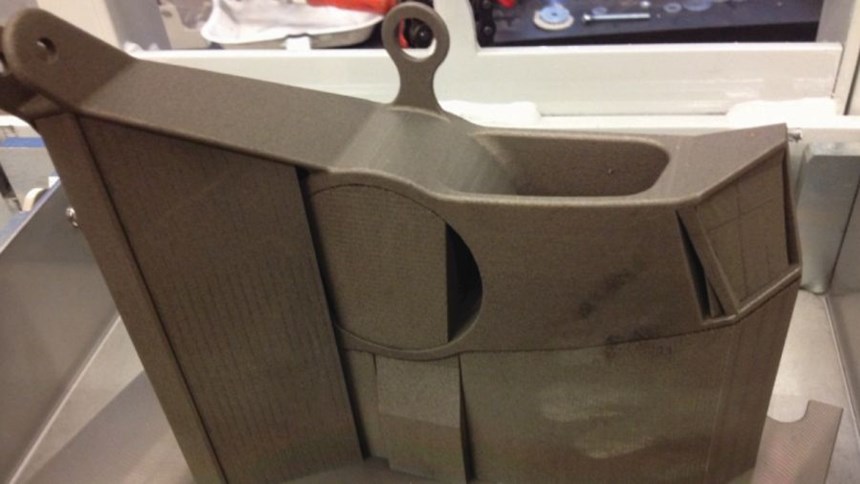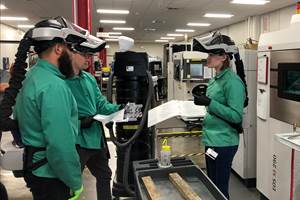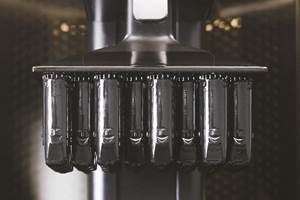Wanted: Flexible Shops and Open-Minded Pros
AM is more complicated than the hype implies. It needs creative people to advance its adoption in this industry.
Share
Read Next
We have all read the hype: You can 3D-print anything you want. Complexity is “free” when using 3D printing. Additive manufacturing is going to put machining facilities out of business. And so on.
Anyone who has actually seen and worked in additive manufacturing—the layer-by-layer fabrication of end-use parts—quickly realizes that the hype is much different from the reality. The reality is that AM is complicated, and we need agile and flexible machining facilities, along with creative and open-minded machining professionals, to help advance the technology and spur its adoption by the industry. Here’s why:
Consider the part pictured above, a component for the front suspension of a Formula SAE race car designed and built by students at Pennsylvania State University. The part is made of titanium, Ti-6Al-4V to be exact, and was designed and optimized by Vincent Maranan, an undergraduate honors student working with Dr. Todd Palmer, a colleague of mine in the materials science and engineering department. Vincent was able to use readily available design, analysis and optimization codes to lightweight the part, which was then 3D-printed on a laser-based powder-fed fusion system, a common AM process for printing fully dense metal parts.
Additively manufacturing this intricate geometry is relatively easy. The machine does not care whether it is “printing” a solid part or a complex lattice; it just tells the laser where to melt the material (a very fine powder in the case of powder-bed fusion systems) so that it solidifies into a solid part. There are numerous caveats, as one might guess, and the most important one—and perhaps the most relevant to readers interested in AM—is the use of support structures to ensure a successful build.
Because the part is being fabricated layer by layer, the heating and cooling of the metal in each layer can cause the part to distort and the ends to warp up (like a potato chip) if overhanging geometries are not properly supported. As a result, you end up having to print the same part with nearly two dozen support structures and in the orientation illustrated in the second image above. Those new to AM often fail to realize that these support structures are fabricated from the same material as the part (titanium, in this case), as current powder-bed fusion systems are limited to a single material. This means large sections of the part need to be removed before end use. The current solution? Clamp the part in a vice and cut, file, grind and hack away the support structures. Not a very advanced solution for post-processing and finishing a lightweight part made with advanced AM technology.
Support removal provides numerous challenges for post-processing and machining: separation of the part and supports from the build plate; establishing datums and reference points for the part for machining; access and clearances to some areas of the structure; and fixturing and workholding in the necessary orientations, to name just a few. This is where AM gets complicated and the reality is different from the hype. Only agile and flexible machining facilities and practices, along with creative and open-minded machining professionals, will be up to the task.
This article originally appeared in Additive Insights, a monthly column in Modern Machine Shop magazine.
Related Content
Postprocessing Steps and Costs for Metal 3D Printing
When your metal part is done 3D printing, you just pull it out of the machine and start using it, right? Not exactly.
Read MoreHow to Pursue a Career in Additive Manufacturing
AM professionals are in demand as 3D printing matures and advances. But what skills are hiring manufacturers looking for? How can applicants prepare? And where can you find relevant job listings?
Read MoreAM 101: Digital Light Synthesis (DLS)
Digital Light Synthesis (DLS) is the name for Carbon's resin-based 3D printing process. How it works and how it differs from stereolithography.
Read MoreAM 101: What Is Hot Isostatic Pressing (HIP)? (Includes Video)
Hot isostatic pressing has long been used for metal castings, but is now being applied as a valuable method for closing porosity in metal 3D printed parts.
Read MoreRead Next
Hybrid Additive Manufacturing Machine Tools Continue to Make Gains (Includes Video)
The hybrid machine tool is an idea that continues to advance. Two important developments of recent years expand the possibilities for this platform.
Read More4 Ways the Education and Training Challenge Is Different for Additive Manufacturing
The advance of additive manufacturing means we need more professionals educated in AM technology.
Read MoreAt General Atomics, Do Unmanned Aerial Systems Reveal the Future of Aircraft Manufacturing?
The maker of the Predator and SkyGuardian remote aircraft can implement additive manufacturing more rapidly and widely than the makers of other types of planes. The role of 3D printing in current and future UAS components hints at how far AM can go to save cost and time in aircraft production and design.
Read More























